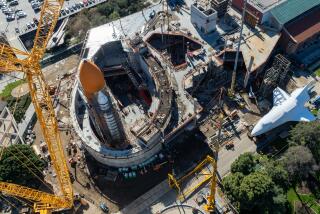Researchers Try to Fix Laser for Data on Satellite
- Share via
HOUSTON — Researchers raced Sunday to solve a laser tracking problem aboard the space shuttle Endeavour before today’s third and final close encounter with a self-stabilizing satellite.
A measuring device in the shuttle cargo bay is designed to precisely gauge the wastebasket-size satellite’s stability when commander John Casper pulls Endeavour within 2,000 feet.
But the tracking system, which works by bouncing laser beams off reflectors on the satellite, gave false readings during a rendezvous Saturday. NASA said the lasers might be reflecting off some other object, possibly even the shuttle itself.
The last shuttle-satellite meeting was postponed a day to allow researchers more time to figure out the problem. If they can’t, they will have to rely on less-precise radar data and videotape shot by the astronauts.
“It’s probably not quite as exact as they would want,” astronaut Daniel Bursch said Sunday in a space-to-ground news conference. “I believe with that video, they’ll still be able to get some excellent science.”
Astronauts fired the laser several times Sunday in an attempt to help ground controllers trouble-shoot the problem.
The cylindrical satellite, weighted on one end by bronze, is designed to stabilize itself in orbit by using its mass and Earth’s magnetic field rather than jet thrusters. If the concept works, future satellites could be cheaper and last longer.
Astronauts ejected the craft from Endeavour on Wednesday with an intentional spin and wobble. They returned a few hours later to find that it was already beginning to stabilize itself.
By Saturday, the 80-pound craft was flying as scientists believed it would, with only a slight wobble and with its weighted end forward.
Although frustrated by the laser-tracking problem, researchers and astronauts said the theory had proved itself.






